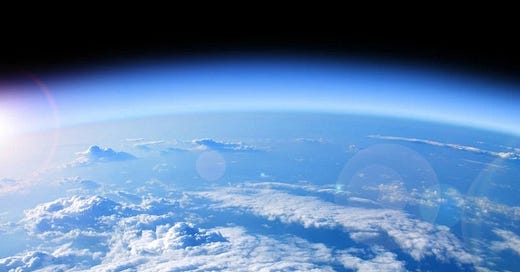🌌 William Shatner's gloomy viral comments about space were ... unhelpful
I prefer the more well-rounded analysis of astronomer Carl Sagan
The contrast between the vicious coldness of space and the warm nurturing of Earth below filled me with overwhelming sadness. Every day, we are confronted with the knowledge of further destruction of Earth at our hands: the extinction of animal species, of flora and fauna . . . things that took five billion years to evolve, and suddenly we will never see them again because of the interference of mankind. It filled me with dread. My trip to space was supposed to be a celebration; instead, it felt like a funeral. - Star Trek actor William Shatner reflecting on his brief voyage into space last year aboard a Blue Origin rocket, as detailed in his new autobiography, Boldly Go: Reflections on a Life of Awe and Wonder.
The above excerpt went viral over the weekend thanks, I guess, to it being featured in Variety magazine. But the quote would surely have possessed less social-media oomph if Shatner was more well known for his roles playing police officer T.J. Hooker or lawyer Denny Crane than the most famous fictional space voyager of all time, Captain James T. Kirk of the U.S.S. Enterprise. We love when the actors playing beloved characters seem to embody a bit of their dramatic creations in their off-screen lives. Tom Hanks appears every bit as decent as Captain Miller in Saving Private Ryan, while Robert Downey Jr. on the red carpet displays all the cool swagger of Iron Man’s Tony Stark.
So given that desire and given my enthusiasm for space exploitation and exploration (as well as Star Trek), I would prefer had Shatner offered us something more Kirkian, something more with the flavor of this:


Did we get the mirror-universe William Shatner?
Indeed, probably no one was more surprised than Shatner that he didn’t slip into Kirk mode when he finally traveled off-planet for real. I mean, you don’t hop aboard a rocket at age 90 unless you eagerly want to see for yourself the wonders of the heavens. It’s not just a bit of late-life thrill-seeking. It’s a capstone to your life’s journey. As Shatner also writes, “Stars exploding years ago, their light traveling to us years later; black holes absorbing energy; satellites showing us entire galaxies in areas thought to be devoid of matter entirely … all of that has thrilled me for years.”
Shatner then explains that he expected the Overview Effect — the sense of awe and oneness with humanity reported by many astronauts — would make his ascent “the next beautiful step to understanding the harmony of the universe.” But, he concludes, “there was no mystery, no majestic awe to behold … all I saw was death.”
Not everyone shares my disappointment with Shatner’s reaction. For those who think a) space efforts are a diversion of resources better applied to problems here on Earth, b) manned spaceflight is too expensive, in both life and treasure, and better handled by robots, and c) skeptical about space and cynical about the “billionaire space race,” Shatner’s quotes are welcome affirmation of their personal hostility. One example that got some Twitter play:
I'm sure Jeff Bezos, one of the emperors of capitalism 3.0 (also known as neoliberalism), did not expect this negative response from Captain Kirk, but socialist and social democratic states of capitalism 2.0 did not abandon human space travel in the 1970s for no good reason. They really found not much out there for us. Space belonged to Sputnik (communication robots), not to Gagarin (colonization).
The brief case for space
I have no idea if Shatner intended to give aid and comfort to the space naysayers who see a zero-sum game between making life better down here and extending life further out there. (I would guess not. I would guess he still thinks space exploration is a worthy human endeavor — just don’t forget about the elephants and rain forests, gang.) But I fear he has, whatever the intent. “Even Captain Kirk thinks space is distraction!” Of course, Earth or Space is a false binary that only obtuse activist-types fail to recognize:
If humanity’s biggest challenge is ensuring its continued existence, then there’s a strong case for space.
If you think devoting 0.5 percent of GDP to space activities doesn’t seem like wild overspending, then there’s a strong case for space.
If you think humanity can do more than one thing at time — during the 1960s America went to space, expanded civil rights, and started cleaning up the environment — then there’s a strong case for space.
If you think some amazing innovations that would make life better here on Earth are possible through a vibrant orbital economy, then there’s a strong case for space.
If you want more abundant resources of all kinds, there’s a strong case for space.
If you think there’s value in adding to the stock of human knowledge about the universe we inhabit — and thus knowledge about ourselves — there’s a strong case for space.
If you think humanity needs a frontier to help keep its culture and institutions vibrant, then there’s a strong case for space.
If you find space to be merely a place of “cold, dark, black emptiness,” as Shatner writes, then there’s a case for filling it with life and thus a strong case for humanity in space.
A different view of the Overview Effect
The closest most of us will get to the Overview Effect might be our reaction to first seeing the “Pale Blue Dot,” that iconic photograph of a pixel-sized Earth against the vastness of space taken on February 14, 1990, by the Voyager 1 space probe as it was leaving the Solar System. The picture was snapped at the request of astronomer Carl Sagan. As he later wrote in his 1994 book, Pale Blue Dot:
From this distant vantage point, the Earth might not seem of any particular interest. But for us, it's different. Consider again that dot. That's here. That's home. … The Earth is the only world known so far to harbor life. There is nowhere else, at least in the near future, to which our species could migrate. Visit, yes. Settle, not yet. Like it or not, for the moment the Earth is where we make our stand. … There is perhaps no better demonstration of the folly of human conceits than this distant image of our tiny world. To me, it underscores our responsibility to deal more kindly with one another, and to preserve and cherish the pale blue dot, the only home we've ever known.

Of the two reflections by actor and astronomer, Sagan gives the more complete picture. Earth must be cherished, preserved, and protected — no one disagrees with this. Certainly not folks such as Jeff Bezos and Elon Musk who are sometimes clumsily accused of wanting to abandon Earth for Mars or some such. (Total strawman.)
But Sagan also saw space as a place of wonder and as a place to which humanity — not just our machines — should venture. In 1991, Sagan wrote an essay about President George Bush’s Space Exploration Initiative, which included a new space station, returning to the Moon, and putting humans on Mars by 2019. He didn’t much care for arguments about technology-spinoffs or even expanding scientific knowledge given the estimated $500 billion cost. But he did have a soft spot for Pale Blue Dot kinds of justifications. Sagan:
… there is a set of less tangible arguments, many of which, I freely admit, I find attractive and resonant. The idea of an emerging cosmic perspective, of understanding our place in the universe, of a highly visible program affecting our view of ourselves — this might have extremely important benefits for us in clarifying the fragility of our planetary environment and in recognizing the common peril and responsibility of all the nations and peoples of Earth. SEI would provide exciting, exploratory, adventure-rich, and hopeful prospects for young people who are ordinarily provided by the mass media and by the incompetence and corruption of politicians with the most dismal view of what their future might be. I've mentioned the importance — somewhat diminished with the end of the Cold War, but still very great — of binding the United States and the USSR in a grand, long-term common endeavor. And then there is the "because-it's-there" argument: Mt. Everest explored by robots would have aroused minimal public enthusiasm, but when humans first conquered it, that was another story.
Sagan ends the essay with a list of things that should probably be done before sending humans to Mars. Among them: an international space station; development of rovers, balloons, and aircraft to study Mars; study of near-Earth asteroids; development of new heavy-lift launch vehicles to replace the Apollo-era Saturn V.
Three decades later: Done, done, done, and done. And Sagan didn’t even anticipate the advances in reusable rockets that are dramatically lowering the cost of getting into orbit and beyond. Yes, Earth continues to be the only place where we can make our stand. But Sagan’s “not yet” moment may be finally counting down. Humanity may be ready for a permanent and growing — and busy — presence off planet. I can’t wait for Shatner to see it begin in earnest.
Micro Reads
▶ NASA’s Asteroid-Smashing DART Mission Deemed a Success - Aylin Woodward, The Wall Street Journal | The first mission to test a technology that one day might protect Earth from a catastrophic asteroid impact achieved its goal on Sept. 26, when a fast-moving spacecraft smashed into and changed the trajectory of a distant space rock, the National Aeronautics and Space Administration said Tuesday. NASA said the intentional collision between its uncrewed spacecraft and the 525-foot-wide asteroid, called Dimorphos, successfully shifted the asteroid’s orbit around a larger asteroid called Didymos. “This is a watershed moment for planetary defense and a watershed moment for humanity,” NASA Administrator Bill Nelson said Tuesday at a press briefing, adding that the mission “shows NASA is trying to be ready for whatever the universe throws at us.”
▶ How California’s Bullet Train Went Off the Rails - Ralph Vartabedian -The New York Times | A review of hundreds of pages of documents, engineering reports, meeting transcripts and interviews with dozens of key political leaders show that the detour through the Mojave Desert was part of a string of decisions that, in hindsight, have seriously impeded the state’s ability to deliver on its promise to create a new way of transporting people in an era of climate change. Political compromises, the records show, produced difficult and costly routes through the state’s farm belt. They routed the train across a geologically complex mountain pass in the Bay Area. And they dictated that construction would begin in the center of the state, in the agricultural heartland, not at either of the urban ends where tens of millions of potential riders live.
▶ How pop culture went multipolar - The Economist | Two things have driven the emergence of multipolar pop culture. The first is economic growth in countries that until recently were poor. Rising incomes give consumers more money to spend, much of which goes to local musicians and film-makers. More money in turn means more artists. … The second factor is the rise of the internet, which has created many more opportunities to put out content. … Online-streaming firms are free from such scheduling constraints, and can host far more content. … Most democratic of all are social-media platforms such as Instagram, TikTok and YouTube, which let aspiring performers anywhere in the world create songs or art that can be distributed at no cost.
▶ All Clear for Takeoff: Evidence from Airports on the Effects of Infrastructure Privatization - Sabrina T. Howell, Yeejin Jang, Hyeik Kim & Michael S. Weisbach, NBER | Our central finding is that [private equity} acquisitions bring marked improvements in airport performance along a rich array of dimensions such as passengers per flight, total passengers, number of routes, number of airlines, cancellations, and awards. Net income increases after PE acquisitions, which does not reflect lower costs or layoffs. In contrast, in the few cases where non-PE acquisitions bring some improvement, it appears to reflect targeting rather than operational changes.
▶ Delta to Invest in Flying-Taxi Maker to Offer Rides to Airports - Alison Sider, The Wall Street Journal | Air-taxi manufacturers raised more than $7 billion from investors over the past two years. However, shares in companies including Joby have fallen sharply as investors grew concerned about potential delays in entering revenue service. … Air taxis aren’t allowed to fly paying passengers right now in the U.S., or elsewhere. Companies involved in the nascent industry have been working to obtain certification for their aircraft and how those vehicles are flown, among other permissions, executives and air-safety officials have said. Earlier this year, the Federal Aviation Administration said it would require air-taxi pilots to have what is called a powered-lift rating, given how the proposed vehicles are expected to vertically take off and land.
▶ Processing Backlogs in the U.S. Immigration System: Describing the Scale of the Problem - David J. Bier, Cato Institute | This brief paper summarizes the basic facts about the immigration backlogs, which comprise roughly 24 million cases across the U.S. government. It demonstrates that backlogs are not isolated within certain portions of the system but are rather a systemic and growing problem for all four departments responsible for executing U.S. immigration law. It also shows that except for visa processing, backlogs have not arisen primarily from COVID-19 shutdowns. Instead, they are a consequence of inefficient agency processes that have caused wait times and backlogs to grow during the past decade. This also means that the agencies culpable for the problem will have the most important roles to play in fixing it.




